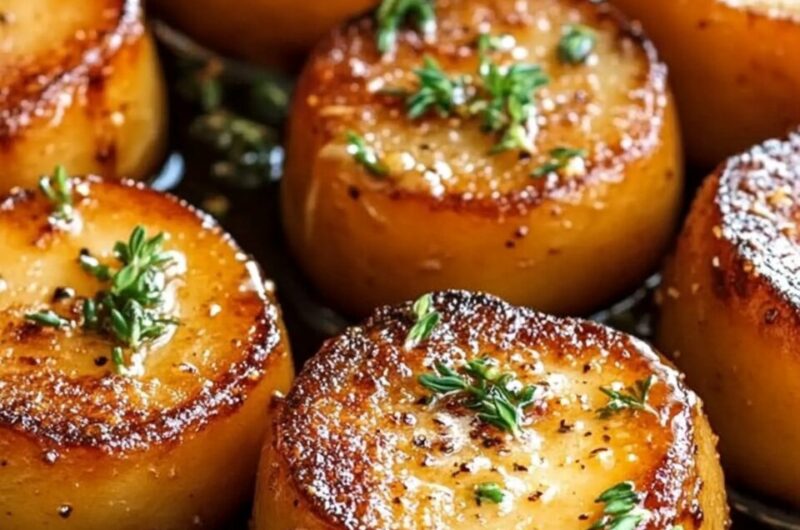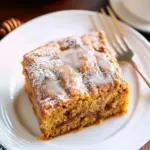Why Fondant Potatoes Are a Culinary Favorite
Fondant potatoes may have a fancy name and an upscale look, but they’re made with some of the most humble pantry staples—potatoes, butter, and broth. What sets them apart is the dual-cooking technique that brings out the best in each component. First, the potatoes are seared for a golden, crusty finish. Then they’re slowly baked in a buttery broth, which seeps into the spuds and turns them luxuriously creamy inside.
This technique, rooted in French culinary tradition, is a favorite among chefs like Gordon Ramsay because it yields maximum flavor with minimal complexity. It’s a testament to how thoughtful preparation and attention to detail can take everyday ingredients to restaurant-quality heights.
Texture and Flavor Profile
The texture of fondant potatoes is their most defining feature. The initial sear in hot oil and butter forms a crisp, golden crust on both ends of the cylinder, offering a satisfying crunch when cut into. The interior, however, is where the true magic lies—thanks to slow oven braising in broth and thyme, the flesh becomes tender, buttery, and almost custard-like.
Flavor-wise, the dish leans into deep, savory notes. The stock infuses the potato with umami richness, while the butter adds silkiness and decadence. Thyme adds an earthy, herbaceous aroma that cuts through the richness, and a touch of garlic (if added) brings a gentle punch that enhances the overall profile. When finished with flaky salt, each bite is a well-balanced blend of crispy, creamy, and aromatic.
Pairing and Serving Suggestions
Fondant potatoes are incredibly versatile when it comes to serving. Their refined look and luxurious texture make them a perfect companion for elegant proteins like filet mignon, rack of lamb, or roasted duck. They’re equally stunning next to a roast chicken, glazed pork chops, or even a vegetarian mushroom steak.
For a complete meal, serve them with a vibrant green vegetable like sautéed green beans, garlic asparagus, or broccolini. A red wine reduction or a creamy peppercorn sauce can further elevate the plate, turning a weeknight dinner into a gourmet experience.
While often served as a side, these potatoes can also shine as the centerpiece of a minimalist meal—perhaps with a side salad, poached egg, or warm baguette.
Why This Recipe Works So Well
Several key techniques make this recipe particularly effective:
-
The Sear: Creating a deep golden crust locks in moisture and starts to caramelize the natural sugars in the potato, adding depth and complexity.
-
Butter Infusion: Melting butter with thyme and garlic infuses the fat with herbal notes that soak into the potato as it cooks.
-
Braising in Stock: Using chicken stock instead of plain water adds an umami base that enhances the richness and rounds out the flavor.
-
Oven Finish: Baking slowly allows the interior to become soft and flavorful without drying out or turning mushy.
These steps may seem small individually, but together they result in a dish that’s refined, balanced, and deeply satisfying.
Health and Nutrition
Though rich in butter and flavor, fondant potatoes can still be enjoyed as part of a balanced meal. Potatoes provide a natural source of vitamin C, potassium, and dietary fiber, especially if left with a bit of peel. The use of chicken stock adds protein and depth without the need for extra salt or seasoning. Butter, while indulgent, adds satiety and a silky texture that defines the dish. Using low-sodium stock helps control sodium intake, and the recipe is easily adjusted by using less butter or opting for a plant-based alternative if needed.
Tips for Perfect Fondant Potatoes
To ensure success, keep these tips in mind:
-
Choose the Right Potato: Floury varieties like Maris Piper, King Edward, or russet potatoes are ideal due to their high starch content, which leads to that fluffy, soft interior.
-
Cut Evenly: Uniform rounds ensure even cooking. Aim for about 6cm wide and 3.5cm tall.
-
Dry Thoroughly: Moisture on the surface of the potato will prevent proper searing. Pat them dry with a paper towel before cooking.
-
Use a Heavy Skillet: Cast iron or a heavy-bottomed pan retains heat better, resulting in a better crust.
-
Baste Often: Spoon butter over the tops of the potatoes during stovetop and oven cooking to enhance flavor and prevent drying.
Recipe Variations
While traditional fondant potatoes use thyme and chicken stock, there’s room for creativity:
-
Herbs: Try rosemary, sage, or bay leaves for a different aromatic touch.
-
Stock: Swap in beef or vegetable stock depending on your main course or dietary needs.
-
Add-On Flavors: Infuse the butter with a splash of white wine, a pinch of nutmeg, or a touch of truffle oil for added luxury.
-
Vegan Version: Use plant-based butter and vegetable broth for a dairy-free, vegan-friendly dish.
Why You’ll Love This Recipe
This dish offers everything you want in a side: crispness, creaminess, flavor, and presentation. It’s surprisingly simple for something that looks so refined, and it’s made with ingredients you likely already have. Whether you’re aiming to impress guests or just elevate your next dinner at home, fondant potatoes hit all the marks. They’re versatile enough to serve with almost any protein and indulgent enough to feel like a treat on their own.
Conclusion
Gordon Ramsay’s Fondant Potatoes are a beautiful expression of what makes comfort food so deeply satisfying—crisp edges, soft interiors, and an infusion of rich, herby flavor in every bite. This dish turns humble potatoes into an elegant side worthy of a fine dining experience. While the method may sound sophisticated, the ingredients are accessible, and the results are consistently outstanding. Whether paired with steak, roast chicken, or served solo with a glass of wine, these potatoes will undoubtedly steal the spotlight on your plate. Once you make them, they’re bound to become a staple in your kitchen repertoire.








